
UCB has developed two UvecoatTM powder coating resins specifically for wood composite substrates such as medium-density fiberboard (MDF). The use of UvecoatTM 1000 as a primer-surfacer can reduce the number of coating layers and, when combined with liquid topcoats, provide an excellent finish. The use of UvecoatTM 1100 in a one-coat textured coating produces an outstanding finish with good surface qualities that has proven to be an attractive method to coat furniture and wall panels.
UCB has also developed the UvecoatTM 2000 series resins for metal applications. Requirements for conventional powder coatings on metal substrates are well known. Evaluations of Uvecoat 2000 series resins have shown that UV-curable powder coatings perform very well on different types of metal substrates. UV-cured powder coatings exhibit good adhesion and film flexibility, and protect properly pre-treated substrates against corrosion. They also exhibit good to excellent weathering resistance when evaluated using accelerated and natural weathering conditions.
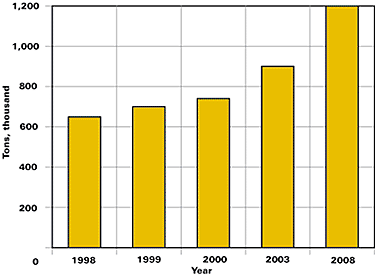
General Benefits of Powder Coatings
For various reasons, powder coating can be considered an ideal technology for the finishing of metal surfaces, not only because of technological and environmental advantages, but also for their economical attractiveness. Given these considerations, the switch from conventional liquid to powder coatings becomes a logical decision.Rapid growth in the use of thermosetting powder coatings over past decades has been driven by a combination of technological, environmental and economic benefits. In the past, growth rates exceeding 10% have been common in powder coating use. An average long-term growth of 6.5% per annum is predicted for the coming 10 years1; the estimated worldwide growth of powder coatings is shown in Figure 1.
A detailed overview of the benefits follows.
Technological Benefits
- The preparation and handling of powder coating formulations are generally easier than for liquid coatings.
- Powder can be applied efficiently on flat and 3-D substrates by electrostatic spray. The over-sprayed powder can be recycled to obtain more than 95% usage.
- One-step attractive finishes can be formulated in unlimited colors with high to low glosses. Also special types of finishes such as texture or hammer finish pose no problem.
- Powder coatings provide outstanding protection of metal substrates. Protective films made from powder coatings conform to many quality standard specifications. Outdoor durable system requirements specified by GSB International (German standard), Qualicoat (class 1 and class 2, European standard) or AAMA 2604-98 (American Architectural Manufacturers Association) are examples of quality specifying organizations.
The main properties specified in all these standards are film adhesion, flexibility of the coating, and chemical, corrosion, and weathering resistance. These requirements can be met by choosing the right powder coating resin/hardener system in combination with the right pigments and additives.
Ecological Benefit
Powder formulations are solvent free with almost no VOCs being emitted during the curing.2This means that powder coatings are an ideal technology to meet new environmental legislative requirements.Economic Benefits
- Material savings. Powder coatings are 100% solids, while liquid paints have a reduced solid content (solventborne paint about 40–45%, waterborne paint about 40%, higher solids about 65%), and need viscosity adjustment generating extra handling costs. Transfer efficiency of powders is 95%, and nearly all powder over-spray can be recycled or reused.
- Energy savings. As powder coatings are solvent free, lower airflow during curing is required. For wet paint, high airflow is required for curing and volatile removal. This results in higher energy costs.
- Labor savings. Powder coatings are ready to use as delivered, do not require online viscosity adjustments or testing.
- Higher operating efficiency. The use of powder coatings allows closer line spacing (no solvent evaporation) with lower rejection rates.
-
Environmental. Liquid paints generate hazardous waste that requires expensive disposal. The waste generation during powder coating is minimal and disposal costs are significantly lower than liquid systems.3
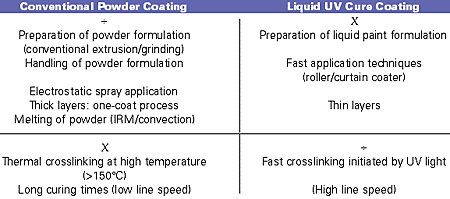 Table 1 / UV Powder Technology: A Combination of Conventional Powder and Liquid UV Technology
Table 1 / UV Powder Technology: A Combination of Conventional Powder and Liquid UV TechnologyFrom Thermosetting to UV-Curable Powder Coatings
Most steps necessary during metal substrate coating with thermosetting powder coatings are also applicable when UV-curable powder coatings are used (see Table 1).- The preparation of a Uvecoat-based UV powder formulation can be done using conventional extrusion and grinding equipment.
- Handling of the powder is comparable; storage stability of UV powder formulations is reduced, but is still very good (34–38°C, 93–100°F), depending on the Uvecoat resin and photoinitiators used in the formulation.
- Spraying can be done with the normal Corona or tribo charging guns.
After electrostatic deposition, thermally curable powder coatings are melted and cured under the influence of heat. Table 2 gives an overview of the different heating technologies used today. To achieve a full cure of thermosetting systems, high temperatures and/or long oven dwell times are required.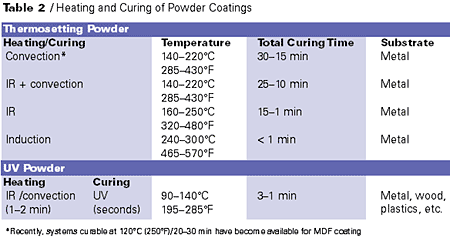 Table 2 / Heating and Curing of Powder Coatings
Table 2 / Heating and Curing of Powder CoatingsLiquid UV-curable coatings are infamous for their very fast curing mechanism and high production speed. It is this crosslinking technology that is used in UV-curable powder coatings (see Table 1): after melting and flow out of the powder under the influence of heat (IR, convection or a combination of both can be used), the molten film is crosslinked by exposing it to UV light.4 In that way, curing becomes a question of seconds instead of minutes as is the case for thermo-hardenable powders. The absence of thermal cure during the melting of a UV powder allows optimum flow out, making smooth finishes achievable at relatively low temperatures (90–140°C, 195–285°F).
The difference between a thermosetting and a UV powder coating curing cycle is represented in Figure 2. Figure 2 / Heating and Curing of Powder Coatings
Figure 2 / Heating and Curing of Powder CoatingsUV-Curable Powder Coatings: Specific Benefits
Until recently, the use of powder coatings has been limited to heat-resistant substrates such as steel.Low temperature requirements in combination with the fast UV curing cycles now allow the use of powder coatings on heat-sensitive substrates such as wood, plastics and heat-sensitive alloys (see Table 2).5,6 A range of UV powder resins has been developed for formulations applicable to such substrates.7 The performance of two different UV powder systems, based on Uvecoat 1000-type resins on MDF, is discussed later in this article.
The use of UV instead of thermosetting powders results in some interesting benefits.8
- Fast curing, higher line speeds and higher productivity can be achieved. For the coating of blanks, heavy metal parts, this can result in considerable energy and time savings.
- Metal parts can be combined with heat-sensitive parts. During the heating and curing phase, the heat-sensitive parts, such as plastic wires or rubber seals, are not damaged because of the lower temperature requirements of UV powder coatings.
Earlier, the excellent protective properties of conventional thermosetting powder coatings on metal substrates were discussed. It is important to note that UV-curable powder coatings impart many of these same properties to protective films. Some important properties, such as adhesion, film flexibility, corrosion and weathering resistance, of Uvecoat 2000-based formulations on frequently used metallic substrates were studied. Results of this study are discussed later.
Some limitations can be found when using UV curable technology, including the following.
- Curing of complex shapes/hidden parts can be problematic.
- Limitations may exist in the choice of colors curable by UV light. For instance, yellow pigments are known to interfere with the efficient curing of liquid UV curable formulations.

Chemistry, Processing, Application and Curing of UV-Curable Powder Coatings
Table 3 shows a brief overview of common curing chemistries used in thermosetting powder coatings. In each case, the primary constituents of the formulation are resin and crosslinking agent (hardener) that react during the heating phase to form a film.By comparison to the thermosetting systems listed in the table, UV-curable powder formulations based on Uvecoat resins have no separate hardener. Uvecoat resins, used in the UV powder systems described below, are polyesters containing (meth)acrylic double bonds9 — a crosslink chemistry common to traditional liquid UV-curable coating technology. The (meth)acrylic bonds are cured by free-radical polymerization through irradiation by electron beam or by UV light. When UV light is used, a photoinitiator is required to activate the polymerization reaction.
A comparison of liquid curable resins to Uvecoat 1000–2000 powder coating resins is listed in Table 4.As can be seen, Radcure liquid products are primarily monomers and oligomers, while Uvecoat resins are solid polymers possessing glass-transition temperatures (Tg) and relatively high viscosities. Semi-crystalline resins (Uvecoat 9000 series), which are characterized by a melting point and a much lower melt viscosity, were not used in this study.
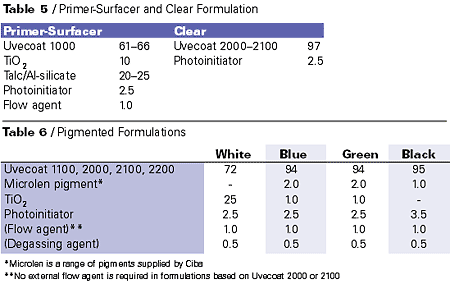
Formulations
The formulations listed in Tables 5–6 were used for testing in this study.- Formulations based on Uvecoat 2000 have excellent storage stability at 35°C; those based on Uvecoat 1100, 2100 and 2200 can be stored at 38°C.
- For optimal curing of the above systems, the use of a benzylketal (e.g., Irgacure 651 (Ciba), Speedcure BKL (Lambson), Esacure KB1 (Lamberti) or alpha hydroxyketone (e.g., Irgacure 2959)-type photoinitiator in combination with a BAPO-type photoinitiator (e.g., Irgacure 819) is recommended.
Application
Electrostatic spraying can be done using a Corona discharge electrostatic spray gun (70 kV) or a tribo-charging gun. For tribo applications, the addition of a tribo additive to the above-mentioned formulations is recommended.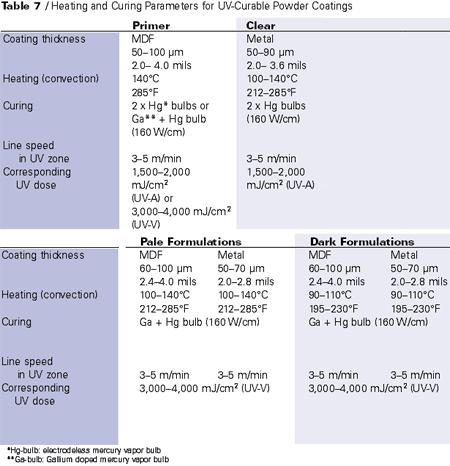
Substrates
- MDF:density = 750–850 kg/m3; uniform density = minimum of 750 kg/m3; humidity content = 4.5–6% Thermal stability = good at 140°C
- Metal substrates: yellow (Cr6+) chromated aluminum (coated within 24 hours after pretreatment); electrolytic chromium coated steel (ECCS)
See Table 7 for recommended coating thickness

Heating and Curing
Heating of the powder for melting and flow out can be done using medium-wave infrared (IRM) radiation and/or convection heat. For these tests, a combination of IRM and convection was used. Under the IR irradiation, the powder melts very quickly. Initially, when the sample passes through the first part of the IR zone, the surface temperature can rise to as high as 160°C (320°F) within a few seconds (note that the IR lamps are set at high intensity.) In the second part of the IR zone with IR lamps at lower intensity and in the convection zone, the molten powder has the time to flow out properly.For dark shades, the intensity of the IR bulbs should be reduced and the convection oven set at lower temperatures. Recommended oven temperatures are shown in Table 7.
An example of a heating cycle that can be used for both MDF and metal applications is shown in Figure 3. Even though this example shows a longer heating time, shorter heating cycles have been successfully used. The molten film is subsequently exposed to UV light.10 Recommended conditions for the different systems are also listed in Table 7.
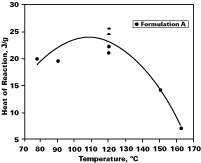 Figure 4a / DPC of UV Powders
Figure 4a / DPC of UV PowdersStudy of UV-Curable Powder Formulations
In order to study the curing behavior of UV-curable powder formulations, two different methods were employed — differential photo-calorimetry (DPC) and rheology. Some interesting results have been obtained using these techniques. DPC measurements carried out using a normal DSC apparatus with a mercury vapor lamp show that an optimized cross-linking efficiency can be achieved at a temperature of approximately 110°C (230°F).11 Figure 4a shows the effect of the temperature of the melt immediately prior to irradiation by UV light on the heat of reaction for a white Uvecoat 2000-based formulation (see Table 6).For the rheological measurements, a modified rheometer with a disposable bottom plate composed of quartz was used. The use of a quartz bottom plate was necessary so the heated sample could be irradiated using a mercury vapor lamp. A good temperature control of the sample was achieved by using an upper oven and air heating of the bottom plate. Using plate to plate oscillation measurements, the visco-elastic behavior of the formulation before, during and after irradiation was studied. Results of this study indicated that a melt temperature of 110°C (230°F) immediate before irradiation was more efficient than 140°C (285°F) (see Figure 4b).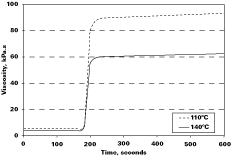 Figure 4b / Rheology of UV Powders
Figure 4b / Rheology of UV PowdersPerformance of UV-Curable Powder Coatings - Applications on MDF
An advantage of electrostatic spraying of powder coatings is the possibility of concurrent three-dimensional application. This makes coating of flat, profiled and 3-D MDF panels simpler than when lamination and other similar technologies are used. However, the density of some grades of MDF is lower internally than at the surface. Lower internal density can create rough surfaces during profiling that result in defects during film formation (because of raised fibers). To avoid this, the following precautions can be taken.- Use MDF with a high density in the bulk of the substrate and sand the profiled parts or the rounded sides before applying the powder.
- Use pressed profiles.
- Friction-smoothing of the profiles.
- First apply a sealing film/liquid primer in the profiles/sides. In some cases, pre-heating the MDF for a short period before profiling can improve the electrostatic spray efficiency. Using the above recommendations, the two systems described below can be used without problems.
UV Powder Primer-Surfacer
Liquid coatings are still the most popular way to finish wood substrates including MDF. When liquid finishing is used, 3–6 layers with sanding steps in-between are required to achieve smooth surfaces.The objective of developing a UV powder primer has been to replace two or more of liquid primer layers by one powder layer. The primer formulation and application methods are shown in Tables 5–6. Subsequent coating of the primer, after proper sanding, with a liquid topcoat can result in an excellent smooth finish exhibiting both high and low glosses. Different types of liquid topcoats, including radiation curable ones, have been tested successfully. Finishing with a UV powder topcoat is also possible.
Properties of the proposed primer, based on Uvecoat 1000, are good sealing, good adhesion to the substrate, good intercoat adhesion with various topcoats, good hiding power, good edge covering on profiled MDF, very good cold check resistance, and very good sandability. Using a UV curable powder primer can increase productivity (reduction in layers + fast application and curing of UV powder), reduce production space requirements, and improve environmental compliance.

One-Coat Textured Finish
Formulations based on Uvecoat 1100 have been developed to provide attractive textured finishes in a one-coat process. The final characteristics of the texture finish can be controlled by varying processing and heating conditions.- The temperature during heating has a small effect on the gloss of the coating
- Special effects (salt & pepper) can be obtained by dry-blending powders with different pigmentation
- The particle size distribution of the powder influences the roughness of the texture
Some key requirements of the furniture industry were tested using several texture colors. Results are reported in Table 8.
This system can be used in applications such as office and bedroom furniture, Hi-fi/TV cabinets, picture frames and wall panels.
Applications on Metal
UV-curable powder coatings based on Uvecoat 2000-type resins all produce high gloss coatings (gloss 60°>90%). Depending on the heating cycle and the type of resin used, smooth to very smooth finishes can be achieved. In general Uvecoat 2000 and 2200 based formulations exhibit greater smoothness than those based on Uvecoat 2100.The key requirements for powder coatings on metal substrates are adhesion, film flexibility, chemical resistance, corrosion resistance and weathering resistance.
Adhesion
Adhesion was evaluated using crosshatch adhesion in accordance with ISO 2409. Taking into account recommended coating thickness, clearcoats and pigmented systems exhibited a very good adhesion (Gt=0).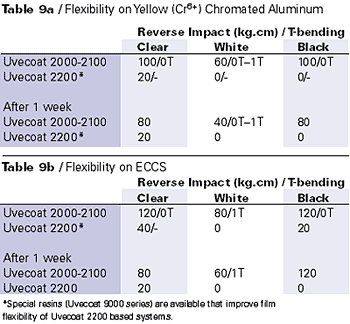
Film Flexibility
Flexibility of each system was tested in a clear, a white, and a black formulation on the substrates mentioned in Tables 9a–9b. Flexibility was evaluated using impact and T-bending resistance test (falling ball test method according to ASTM D 2794 for impact resistance and T-bending according to ASTM D 4145). Tests were performed at a temperature of 22 ± 2°C (72 ± 4°F) after one hour. Aging of impact resistance was tested after one week. Flexibility of Uvecoat 2000 and 2100 based formulations was similar and therefore listed as a single entry in the table.Uvecoat 2000-2100 based systems exhibit very good flexibility on different substrates. Impact resistance of formulations based on Uvecoat 2200 was quite low except in clearcoats where some degree of flexibility existed. From our expertise with thermosetting powders we know that this limited flexibility is due to the chemical structure of the polymer.

Corrosion Resistance
Besides maintaining gloss levels when exposed to weather, a coating also has to protect the metallic substrate from corrosion. Although coating properties can effect corrosion resistance, the quality of the metal pre-treatment is equally important for preventing delamination and blistering at the film/metal interface.For this study, freshly yellow (Cr6+) chromated aluminum and electrolytic chromium coated steel (ECCS) panels were employed. Corrosion resistance was evaluated in a clear and a white formulation using copper accelerated salt spray (CASS) and filiform corrosion testing. For both tests, the coated panel was scribed.
The CASS test was performed according to ASTM B 368. This test uses a 5% salt solution containing Cu(II)-chloride and glacial acetic acid; exposure time is 240 hours. Both scribe failure (delamination next to the scribe) and formation of blisters was rated (see Table 10).
During filiform corrosion testing, the sample was first subjected to hydrochloric vapor to generate a corrosive attack (induction). Following vapor exposure, the panels were stored at 40 ± 2°C (104 ± 4°F)/ 82 ± 3% relative humidity for 1,000 hours. Immediately following testing, the length and the frequency of the filaments formed from the scratches are estimated and an average value is determined in relation to filament length (l mm), filament frequency (H, mm-1) and the product of both measurements (F = l * H). This test was only performed on yellow chromated aluminum panels (see Table 11). Results for Uvecoat 2000 and 2100 systems were comparable.
All UV powder systems tested exhibited good corrosion resistance on chromated aluminum and ECCS. Their performance was comparable with a conventional thermosetting outdoor durable powder coating system.
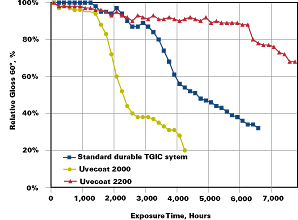 Figure 5 / QUV-A of White UV Powders
Figure 5 / QUV-A of White UV PowdersWeathering Resistance
UCB has considerable expertise in testing outdoor durable thermosetting powder coatings. One valuable accelerated weathering method that is frequently used to predict the durability of new polyester resins is the QUV-A test. UV-A bulbs produce a close reproduction of the solar spectrum at approximately 350 nm thus providing a good correlation with natural exposure in Florida. One important prerequisite is the right choice of pigment. Pigment choice can have an important effect on the coating durability.Different Uvecoat systems were tested in a white RAL9010 formulation and compared with a standard outdoor durable TGIC based system using QUV-A. The cycle used was in accordance with ASTM G53-88. Panels were subjected to the alternate effects of condensation (4 hours at 50°C(122°F)) as well as the damaging effects of sunlight simulated by the fluorescent UVA lamps (340 nm/ I=0.77 W/m2/nm) (8 hours at 60°C (140°F)).
Relative gloss, at an angle of 60°, was measured as a function of exposure time (see Figure 5).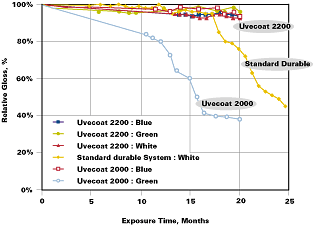 Figure 6 / Florida Natural Exposure of Pigmented UV Powders: Gloss Retention
Figure 6 / Florida Natural Exposure of Pigmented UV Powders: Gloss RetentionThe results represented in the figure show that the Uvecoat 2000-based formulation did not perform as well as the TGIC standard. (Similar results were obtained for Uvecoat 2100-based formulations.) The formulation based on Uvecoat 2200 performed much better than the standard TGIC control (> 65% gloss retention after 7000 hours exposure).
In 1998, pigmented formulations based on Uvecoat 2200 were sent to Florida for natural exposure testing (45° south). Gloss retention results of a blue, green, and white coating are shown in Figure 6.
Color retention of the blue and green formulations is shown on Figure 7. Uvecoat 2000 (and 2100) based systems showed a gloss reduction of 50% after approximately 16 months exposure. After 20 months exposure, all Uvecoat 2200 based systems exhibited a relative gloss of more than 95% and (delta E) lower than 2. This confirms the excellent outdoor durability of Uvecoat 2200 systems.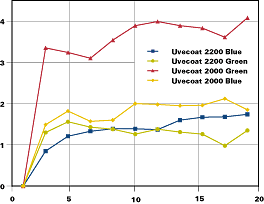 Figure 7 / Florida Natural Exposure of Pigmented UV Powders: Color Retention
Figure 7 / Florida Natural Exposure of Pigmented UV Powders: Color RetentionUV powder coatings based on Uvecoat 2000, 2100 and 2200 are well suited for outdoor applications.
Conclusion - Benefits
In addition to technological and environmental advantages, thermosetting powder coatings also provide economic advantages. Powder coatings cured with UV light offer increased benefits over thermosetting coatings such as faster curing cycles with lower temperature requirements. This allows heat sensitive substrates such as wood, plastics, and heat-sensitive alloys to be coated using powder. Coating of parts containing both metallic and heat-sensitive substrates becomes possible when UV powder coatings are used. UV-curable powder coatings can facilitate higher line speeds, higher productivity, as well as time, energy, and space savings.Performance
For the coating of wood composite substrates, such as medium density fiberboard (MDF), 2 different UV powder systems based on Uvecoat 1000 type resins have been developed. The use of a UV powder primer-surfacer can reduce the number of coating layers. A UV powder primer can be coated using various types of (liquid) topcoats to achieve excellent finishes. A one-coat textured finish with good surface qualities is an attractive method to coat furniture, wall panels, etc.Requirements for conventional powder coatings on metal substrates are well known. Evaluation of UV-curable powder coating properties has shown that coatings based on Uvecoat 2000 type resins perform very well on different types of metal substrates. Besides good adhesion and film flexibility, the coatings protect correctly pre-treated substrates against corrosion and exhibit good to excellent weathering resistance when exposed in accelerated or natural weathering conditions.
Acknowledgement
The authors would like to thank Dr D. Maetens and C. Zune for their contribution to this article.For more information on resins for UV powder coatings, contact UCB Chemicals Corp., 2000 Lake Park Drive, Smyrna, GA 30080; phone 800/894.8527 or 770/801.3201; fax 770/801.3200; visit www.chemicals.ucb-group.com; e-mail .
Links

Report Abusive Comment